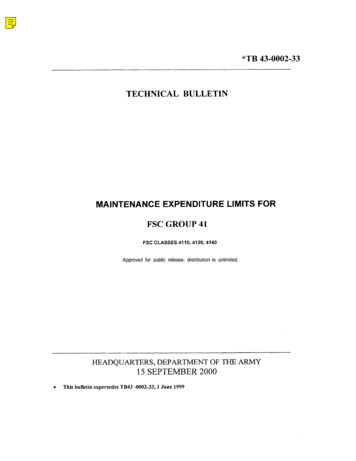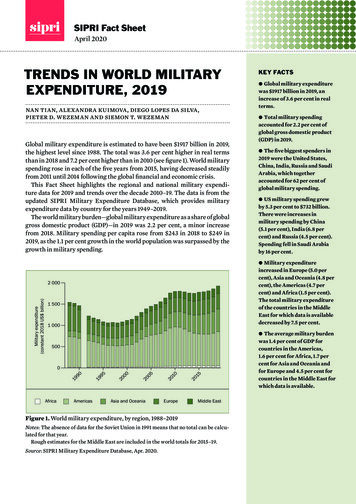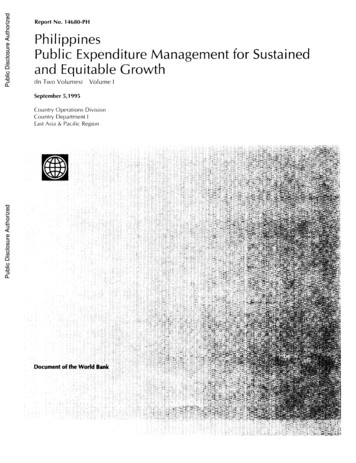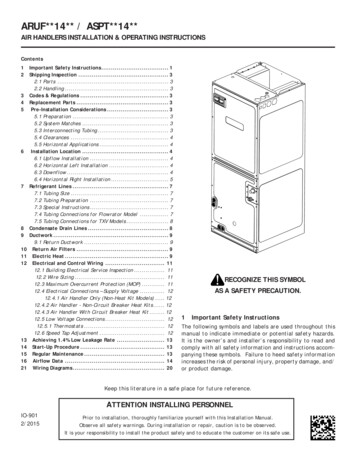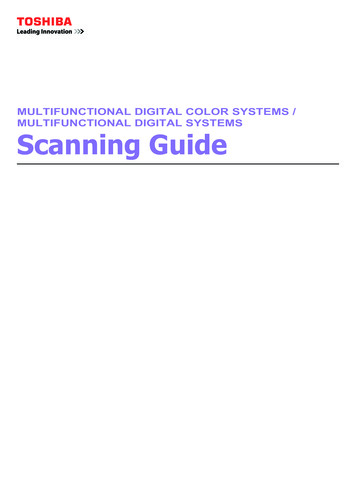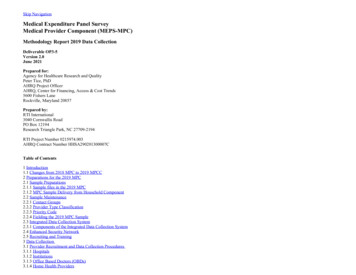
Transcription
Skip NavigationMedical Expenditure Panel SurveyMedical Provider Component (MEPS-MPC)Methodology Report 2019 Data CollectionDeliverable OP3-5Version 2.0June 2021Prepared for:Agency for Healthcare Research and QualityPeter Tice, PhDAHRQ Project OfficerAHRQ, Center for Financing, Access & Cost Trends5600 Fishers LaneRockville, Maryland 20857Prepared by:RTI International3040 Cornwallis RoadPO Box 12194Research Triangle Park, NC 27709-2194RTI Project Number 0215974.003AHRQ Contract Number HHSA290201300007CTable of Contents1 Introduction1.1 Changes from 2018 MPC to 2019 MPCC2 Preparations for the 2019 MPC2.1 Sample Preparations2.1.1 Sample files in the 2019 MPC2.1.2 MPC Sample Delivery from Household Component2.2 Sample Maintenance2.2.1 Contact Groups2.2.2 Provider Type Classification2.2.3 Priority Code2.2.4 Fielding the 2019 MPC Sample2.3 Integrated Data Collection System2.3.1 Components of the Integrated Data Collection System2.4 Enhanced Security Network2.5 Recruiting and Training3 Data Collection3.1 Provider Recruitment and Data Collection Procedures3.1.1 Hospitals3.1.2 Institutions3.1.3 Office Based Doctors (OBDs)3.1.4 Home Health Providers
3.1.5 Pharmacy3.1.6 Separately Billing Doctors (SBDs)3.2 Data Abstraction3.3 Coding Text Fields Collected in the 2019 MPC3.4 Data Collection Schedule3.5 Data Collection Results3.5.1 Completion Rates3.5.2 Refusal Conversion3.5.3 Components of MPC Data Collection3.5.4 TimingAppendix A: Acronyms and DefinitionsAppendix B: MPC Data Collection Summary TablesAppendix C: Critical ItemsTable 2-1 Household Component Design Features related to the MPCTable 3-1 Percent of Participating Contact Groups that Provided Records, 2016-2019Table 3-2 MPC Data Collection Schedule 2016-2019Table 3-3 Provider-Level Completion Rates, MPC 2016-2019Table 3-4 Pair-level Completion Rates, MPC 2016-2019Table 3-5 SBD Node-Level Completion Rate, MPC 2016-2019Table 3-6 Refusal Conversion Outcomes: MPC 2016-2019Table 3-7 Hours per Completed Pair, 2016-2019 MPCFigure 3-1 Hospital providers: Response factors over timeFigure 3-2 Office-Based providers: Response factors over timeFigure 3-3 SBD providers: Response factors over timeFigure 3-4 Pharmacy providers: Response factors over timeTable B-1 MPC Sample Sizes, Provider Level, 1996-2019Table B-2 MPC Sample Sizes, Pair Level, 1996-2019Table B-3 MPC Data Collection Results, Provider Level, 1996-2019Table B-4 MPC Data Collection Results, Pair Level, 1996-20191. IntroductionThe Medical Expenditure Panel Survey (MEPS) has been conducted by the Agency for Healthcare Research and Quality (AHRQ) each year since 1996. MEPS is a set of largescale surveys of families and individuals, their medical providers, and their employers across the United States. MEPS collects data on specific health services, includingfrequency of use, costs, and sources of payment for services, and on the cost and scope of health insurance covering U.S. workers.This report describes the methodology of the 2019 Cycle of the MEPS Medical Provider Component (MPC1) . The MEPS-MPC collects data from Hospitals, Office-BasedDoctors, Home Health Agencies, Institutions (such as long-term care facilities) and Pharmacies reported by MEPS Household Component (HC) respondents as well as doctorswho provide services for patients in Hospitals but bill separately from the Hospital (referred to as Separately Billing Doctors or SBDs). (See Section 2.1 for additional informationabout provider types.) The MEPS-HC is conducted by Westat, Inc. and the MEPS-MPC is conducted by RTI International and Social & Scientific Systems, Inc. (SSS, a DLHHoldings Corp. Company).Each cycle, providers for the MPC sample each year are identified in three rounds of HC data collection for two HC panels (see Table 2-1). Overall the HC panel design featuresfive rounds of interviewing over the course of two full calendar years. The HC collects data from a sample of families and individuals in selected communities across the UnitedStates, drawn from a nationally representative subsample of households that participated in the prior year’s National Health Interview Survey (conducted by the National Centerfor Health Statistics of the Centers for Disease Control and Prevention).The household interviewscollect detailed information for each person in the household including demographic characteristics, health conditions, health status, use of medicalservices, charges and source of payments, access to care, satisfaction with care, health insurance coverage, income, and employment. To support the MPC, the HC further collects
signed Authorization Forms (AFs) from those respondents who indicated using medical services during the reporing period. These AFs allow the MPC to contact the respondentmedical providers to request both the medical record and billing data associated with the reported respondent medical events.Return to Table of Contents1.1 Changes from 2018 MPC to 2019 MPCIn preparation for the start to the 2019 MPC cycle data collection, recommended Contact Guide and Event Form changes was submitted to AHRQ for review and approval. Thisincluded not just the routine change of updating the reference year from 2018 to 2019, but also the movement of the Hopsital, OBD, Home Health, and Institution Event Formsfrom Hatteras software to Blaise software (following a similar change made to the Pharmacy and SBD Event Forms prior to the 2018 MPC cycle data collction). The move toBlaise necessitated some relatively minor changes in instruments across provider types due to differences between Hatteras and Blaise, such as:Changes in onscreen instructions for data collectors due to operational differences between Hatteras and Blaise. For example, dates in Hatteras were collected with differentfields for month, date, and year. In Blaise, these are captured in one field.Changes to structure of questions such as the Hospital inpatient event begin and end date question. In Hatteras, this is one question, but Blaise requires that this be twoquestions, although the underlying content of the question is unchanged.The collection of diagnoses is two questions in Blaise instead of one in Hatteras. In Hatteras the question asks once, "I need the diagnosis for this visit. I would prefer theICD-10 codes or the DSM-5 codes, if they are available." The same question is asked in Blaise. But if a code cannot be supplied, a follow-up item prompts, "I need thediagnosis for this stay" in order to collect the description.The Contact Guide was also moved from Hatteras software to a custom built windows MVVM .net desktop module, and the various Contact Guide versions for each provider typewere consolidated into one. While item wording was retained as much as possible, there were some changes to items due to (a) the change in programs from Hatteras to thedesktop module, and (b) the combination of Contact Guides for different provider types into one Contact Guide for all provider types.Other changes for the 2019 cycle included:The addition of a hard check to the Hospital, OBD, Home Health, Institution, and SBD Event Forms to require a reason for payments being less than charges,Updating of the question wording for clarity in the Hospital and Institution Event Forms for collecting an "other specify" SBD specialty and role,Added a graphic to the Hospital, OBD, Home Health, and Institution Event Forms that shows the correct format of ICD-10 and DSM-5 codes,Added a fill of "in long term care" for the Hospital Event Form items that collect a DRG code for inpatient stays and collect the full charge, when the location of service isin a long term care unit,Eliminated the skipping of Event Form questions and DCS instructions based on data collection mode (telephone or abstraction), so screens display identically for bothmodes,Improved the logic that uses terms in the diagnosis descriptions in the Hospital and Institution Event Forms to programmatically determine whether certain specialties areexpected as SBDs within an event,Disallowed Don't Know and Refuse responses for the Home Health and Home Non-Health Event Form item capturing billing period length,Eliminated the skipping of the OBD Event Form location of service for a global fee date if the date is Don't Know or Refuse,Reinstated an instruction in all Non-Pharmacy Event Forms that directs DCSs to indicate a patient is not an eligible veteran if the POC does not understand the question,In Non-Pharmacy Event Forms, added a hard check if a DCS enters No when confirming that total payments were less than total charges – requiring a correction tocharges/payments or an answer of Yes,Corrected ICD-10 formatting guidance when entering diagnosis codes in place of inpatient procedural codes in the Hospital event form,Upgraded the Contact Guide to allow identification of multiple primary POCs for a single contact group,Added two POC categorization options in the Contact Guide to better identify records/billing service POCs who work on-site at a provider's facility,Moved the Provider Confirmation screen from the Case Management System (CMS) into the Contact Guide and programmed it to be asked of each primary POC,Moved the processes for sending AF packets and dispositioning calls from the CMS into the Contact Guide,Eliminated a Pharmacy Event Form item that collected Healthcare Common Procedure Coding System (HCPCS) codes from facilities supplying only durable medicalequipment, because data are no longer captured from those facilities,In the Pharmacy Event Form, added new dosage forms (vaginal ring, pen, powder for solution, and emulsion) and quantity units (pen needles, blisters, inhalations).In the Pharmacy Event Form, changed dosage form designation for caplets to CAPL from CAP,Started collecting in the Contact Guide whether a Pharmacy is a military provider, andCustomized a prompt in the Contact Guide for Pharmacy providers, to correctly name the types of billing forms being requested.Detailed information about item wording and instrument flow is available in Deliverable OP3-12, MPC 2019 Final Data Collection Instruments.
The onset of the COVID-19 pandemic in the U.S. in mid-March 2020 required the data collection team to substantially alter plans and assumptions to accommodate remoteoperations that helped ensure the safety and health of project staff. The team transitioned to remote data collection in March, following facility closure. As a result of many state,county, and municipal "stay-at-home" mandates, provider points of contact (POCs) became more difficult to reach and struggled to adapt technologically, overcoming system andfax access issues, staff shortages, and reduced hours onsite, among other impacts. By September 2020, the MPC data collection team's staffing began to stabilize. While mostprovider POCs had also adjusted to remote work and began to process requests more routinely, there were still lengthy and longer than normal turnaround times for receivingrecords at the end of the data collection cycle.Because both the MPC data collection activities and staff at provider organizations were deeply impacted by the upheaval resulting from the national health emergency, theamount of data collected by the MPC was considerably less in calendar year 2020 than is typical. Fewer providers had the staff resources and technology accommodations toparticipate under the initial COVID-19 circumstances. In particular, participation was negatively impacted among providers with larger numbers of patient-providers pairs, andespecially among the OBD providers. An additional impact is that data collected contained fewer than average medical events per patient-provider pair. Also, the addition of newstaff to counterbalance attrition experienced in the initial transition from onsite to remote work along with new procedures and systems introduced to accommodate remote workunintentionally but not unexpectedly increased the abstraction error rates above those experienced in a normal cycle, although error rates were maintained beneath the 2%threshold.Necessary IT system enhancements and overhauls were implemented between April through September that allowed for offsite abstraction and improved records management forremote staff. System enhancements and improvements included:Providing abstractors with the ability to highlight data elements within PDF files of records online in place of the previous process of highlighting hardcopy records inpreparation for abstraction,Creating an electronic Abstraction Notes Form (eANF) to replace a hardcopy version used by abstractors to build efficiency into the abstraction process, andReplacing the filing system for hardcopy records with a Document Processing Module to streamline the receipt, archiving, and accessing of electronic and scanned records.Return to Table of Contents2. Preparations for the 2019 MPCThis section describes the 2019 MPC provider sample and preparations for data collection, including grouping patient-provider pairs by provider, grouping providers for thepurpose of contacting facilities, and updating locating information.Return to Table of Contents2.1 Sample PreparationsRespondents in the HC are asked to identify all medical providers associated with healthcare services received by each member of the household for the reference periodassociated with the time period of the interview date. Thus, the basic sample unit in the MPC is a patient-provider pair (referred to as a “pair”) where the patient is a member of ahousehold participating in the HC and the provider is identified in the household survey as one associated with a medical event (i.e., an office visit, a Hospital stay or visit to anoutpatient or emergency department, a prescription for medicine, or other healthcare event). To facilitate the MPC contacting medical providers household members are asked tosign an Authorization Form (AF) indicating their agreement to allow providers to release medical record and billing information about the event to the MPC. This form iscompliant with the Health Insurance Portability and Accountability Act (HIPAA) implemented in 2003.Within the HC, the term “medical provider” is intended to include any type of practitioner contacted by the household for what the household considers to be healthcare—hospitals, clinics, long-term care institutions, HMOs, medical doctors and doctors of osteopathy, dentists, home care providers, optometrists, podiatrists, chiropractors,psychologists, and other practitioners.Eligibility for the MPC is restricted to services rendered in a hospital or by a medical doctor or doctor of osteopathy (MD or DO) or under the supervision of a MD or DO. TheMPC excludes services provided by dentists, optometrists, psychologists, podiatrists, chiropractors, and other kinds of healthcare practitioners who do not provide care under thesupervision of a MD or DO. Care provided by home care agencies is an exception to this criterion; the sample design includes all care provided through a home care agency.Pharmacies reported as sources of prescription medicines obtained by household respondents make up a fifth group of MPC pairs generated from the MEPS-HC. However, theMPC excludes pharmacies that provided durable medical equipment (DME) only and no prescriptions. Finally, additional pairs identified during the MPC data collection as SBDsare identified in medical records obtained from Hospitals and Institutions.In summary, provider types included in the MPC are:
Hospitals—Providers associated with an inpatient stay as well as hospital outpatient department or emergency roomInstitutions—Long-term care providersPharmacies—Pharmacies (corporate and non-corporate) where household respondents obtained or purchased prescription medicinesOffice-Based Doctors (OBDs)—PhysiciansHome Health—Providers associated with care provided in the home of the household respondent, including either healthcare (Health Agencies) or other services excludinghealthcare (Non-Health Agencies)Separately Billing Doctors (SBDs)—Providers added to the MPC sample during abstraction of medical and patient account records of Hospitals and Institutions. Charges andpayments for their services are not included in the Hospital or Institution financial records and must be obtained by contacting the offices of the SBDs.Return to Table of Contents2.1.1 Sample files in the 2019 MPCThe HC contractor prepared pair data from the computer assisted personal interview (CAPI) survey instrument used in the HC. For Non-Pharmacy pairs, the file includes pairswith eligible dates of utilization (that is, calendar year 2019). In the file for Pharmacy pairs, the events (prescriptions) are not dated. Files for all provider types include theAuthorization Forms (AF) signed by the household respondents. AHRQ subsampled OBDs at the HC Reporting Unit (RU) level, and delivered the extracted MPC sample files toRTI. The 2019 MPC OBD subsampling rate was 60%. Table 2-1 summarizes design features of the HC related to the MPC.Table 2-1. Household Component Design Features related to the MPC2016201720182019Panel 20, Panel 21, Panel 21, Panel 22, Panel 21, Panel 23, Panel 24, Panel 24,Year 2Year 1Year 2Year 1Year 2Year 1Year 2Year 1(Round 5) (Round 3) (Round 5) (Round 3) (Round 5) (Round 3) (Round 5) (Round 3)No. of PSUs for household 6,5846,703na 1na 1Subsampling of Office-Based Doctors in CAPINoNoNoNoNoNoNoNoSubsampling of Office-Based Doctors after CAPIYesYesYesYesYesYesYesYesNo. of household interviewsSources: MEPS Household Component Annual Methodology Report ( July 15, 2020 ) Westat, Inc, Table 1.1 and Table 4.2.1 The number of completed household interviews for these Panels/Rounds was not available in Table 4.2 of the July 15, 2020 Household Component Methodology Report.Input to the MPC sample was provided in six separate files.1. Records in the main sample file were identified at the pair (PAIRID) level. All other files used to construct and load the sample were merged with this file. This fileidentified the MPC cases loaded into the Integrated Data Collection System (IDCS) Control System (CS) and tracked throughout the MPC data collection period. For thepurposes of data collection in the MPC, the CS tracked at the event level, pair level, and provider level. During the matching process, the MPC data collected was linkedback to the pairs from this original HC sample file.2. The person file contained identifying information for every household member associated with a pair in the main sample file. The file can be merged with the main sampleusing the person ID (PERSID).3. Provider contact information is contained in the NPI provider directory used by HC interviewers and the monthly non-matched files delivered by Westat containingproviders not found in the NPI directory. For providers identified in the NPI directory, the provider ID (PDDIRID) is the NPI ID (NPIPRVID) from the NPI directory. Forproviders not identified in the directory, the provider ID (PDDIRID) is the PROVID assigned by Westat in the monthly files of non-matched providers. Both files contain
provider name and contact information. For the non-matched providers, the contact information is the provider name and address that was provided by the HC respondent.The contact information was then loaded into the control system as part of the MPC case.4. The Pharmacy directory file can be merged with the main sample file using PHADIRID (same as PDDIRID) so that the name and contact information of the Pharmacycan be loaded as part of the Pharmacy case.5. Beginning with the 2017 HC, a Pharmacy NPI directory was used by the HC interviewers to assign IDs to pharmacies. If a match was found, a pharmacy NPI ID wasassigned to the pharmacy reported by the HC respondent. The pharmacy NPI directory was delivered with the sample files and was merged with the main sample file usingthe Pharmacy NPI ID (NPIPHAID).6. Beginning with the 2018 cycle, RTI developed code for assigning pharmacy chain codes by searching for text strings in the pharmacy names.Return to Table of Contents2.1.2 MPC Sample Delivery from Household ComponentFor the 2019 MPC, Westat extracted the sample files used for inclusion in the MPC sample in four waves. Westat delivered the Pharmacy sample files directly to RTI. The NonPharmacy files were first delivered to AHRQ for OBD subsampling and then forwarded to RTI for processing. The waves of sample files were delivered to RTI in January (Wave1), April (Wave 2), May (Wave 3), and July (Wave 4) of 2020. Wave 3 was supplemental sample that primarily included OBD pairs. The supplemental Wave 3 sample was addedto allow for pairs to be more easily completed, given the challenge of reaching some providers during the COVID-19 pandemic. A total of 53,330 pairs were in the 2019 MPCsample derived from the HC; 39,192 (73.5%) in Wave 1 of sample delivery; 6,756 (12.7%) in Wave 2; 2,500 (4.7%) in Wave 3; and 4,882 (9.2%) in Wave 4.The following data elements were included in the MPC sample in order to identify each pair:Unique person and Provider IDs used to link the data collected through the MPC back to the household-generated data for the matching processIdentifying information of the household member, such as name, address, gender, and date of birth, parent name if person under age 18, spouse name (if married), andpolicy holder name for insured personsIdentifying information about each provider, such as name, address, and telephone numberAt the pair level, the number of each type of event identified for the person for that provider and any other HC variables necessary to assign priority flags (see section 2.2.4below).These data elements are necessary to define a pair, a key data collection unit of the MPC. The extracted file records were sorted so that all pairs for a provider were listed together,thereby creating provider-level records. (For more information about the data elements included in the extraction files, see the deliverable OP3-6/8/9 – Consolidated SampleImplementation Plan for the 2019 MPC. )Return to Table of Contents2.2 Sample MaintenanceIn order to facilitate data collection, RTI sorted providers into contact groups, that is, groups where several providers share the same contact information (e.g., telephone number,practice name, street number, and provider name). Potential groups were carefully reviewed to confirm that grouping was appropriate. In the formation of contact groups, provideridentification numbers and other detailed information from the HC were preserved to assure accurate linkages back to the initial sample files. During the MPC data collection, theIDCS enabled contact groups to change as facilities could be restructured, bought out by other entities, or change location of the medical and/or patient account records.Return to Table of Contents2.2.1 Contact GroupsAll pairs were assigned to contact groups. A pair was assigned to a contact group first by checking whether the provider in the 2019 MPC sample was in a previous cycle’s MPCsample. If so, the pair was assigned to the provider’s most recent contact group. Providers not found in a previous MPC sample were grouped to form a new contact group basedon the provider’s contact information. An automated process grouped pairs by telephone number, address fields, and a SOUNDEX program in SAS to identify similar practice orprovider names.As in prior cycles, before delivery of sampled pairs, Westat checked for duplicate pairs based on unique identification numbers assigned to each person (PERSID) and provider(PROVID). The sample preparation process at RTI included further checking for duplicate pairs by searching the sample files for pairs that had the same PERSID and NPIidentifier but a different PROVID. When duplicate pairs were identified, one pair was assigned a code that indicated the pair had been merged. This merged code was used to
prevent the pair from being fielded. The other pair was fielded for data collection.An additional check searched pairs within the same RU for instances where pairs had the same provider telephone number (reasoning that in these situations, providers with thesame telephone numbers might be the same individual). Suspected duplicate providers were confirmed through manual review of provider names and addresses and, if associatedwith the same person, merged as above.All Veterans Administration (VA) providers were grouped together because of their common organizational structure that makes them significantly different from the otherproviders in the sample. Once records were receipted, VA providers were assigned to a small group of Hospital abstractors so that they could be worked consistently.Similarly, HMO providers were grouped together and assigned to a small team to coordinate contacts with common corporate offices rather than with the individual providers.This grouping facilitated efficient contacts for recruiting HMO providers into the study and helped to make records abstraction more consistent and efficient.Return to Table of Contents2.2.2 Provider Type ClassificationProvider type classification in the MPC is critically important operationally for several reasons. Because Hospital events are likely to be associated with high expenditures, it isimportant to track provider type participation to assure that Hospital providers are responsive to the survey. Hospitals are often complex environments, especially for datacollection projects, and thus the MPC data collection instruments are designed to assist the data collection staff in dealing with multiple points of contact within the Hospital andwith potentially more complicated medical records and patient account information. The MPC Hospital data collection forms are also designed to facilitate the collection of SBDinformation associated with Hospital events.Provider type was assigned at both the pair level and the provider level. The initial provider type for the pair was assigned during the HC interview when the household respondentidentifies the type of medical events associated with a medical provider. During sample processing, the household provider type is updated. First, labs and dialysis centers,VAproviders, imaging centers, and surgery centers are assigned a Hospital provider type. Second, providers are assigned a Hospital provider type if they were in a Hospitalcontact group in the previous wave.Note that the provider type assigned during the HC could have been incorrect because of a household respondent’s misunderstanding about a provider’s status. Typically, thisoccurred when a household respondent confused Hospital and Office-Based Doctors. Efforts were made to correct the classification during sample preparation and during the fieldperiod.Following the sorting of provider pairs into contact groups, RTI reviewed the composition of contact groups to see if provider classification at the pair level was consistent withincontact group. Inconsistencies, such as an OBD pair in a Hospital contact group, were resolved by creating a new contact group, so that all providers within a contact groups wereconsistent.In addition, during data collection, staff periodically learned that the provider type was incorrect and the field was updated so that the appropriate event form could beadministered. The most common change was to a Hospital provider from another provider type, typically an OBD provider. This provider type change was important so that theappropriate Hospital Event Form could be used to collect SBD information. Updating provider type was uncommon among other provider types.As a result of such provider type changes during sample preparation and during data collection, in the 2019 MPC the count of Hospital pairs increased by 1,613 pairs, an increaseof 16% between the count of Hospital pairs in the HC sample and the count at the close of the field period. Among changes to Hospital provider, 76% occurred during samplepreparation and 24% during data collection. The overall count of Home Health pairs increased by 47, an increase of approximately 5%. The overall count of Institution pairsstayed the same and the overall count of OBD pairs decreased by 1661 (7.3%).Return to Table of Contents2.2.3 Priority CodeA priority code was attached to both providers and person/provider pairs. High priority cases include patients or providers expected to be associated with high costs. These prioritycases were closely tracked and monitored during MPC data collection using production reports that track the progress of completing these priority cases. Priority flags wereattached at the person level to ensure that contact groups with patients having priority flags were given priority by the data collection staff when working MPC cases. Priority flagsset at the person level were rolled up to the provider and contact group levels. A priority flag was set if the person met one or more of the following criteria:
Hospital stay or Home Health eventDeceasedInstitutionalized in a healthcare facilityOutpatient or office visit surgery.If an SBD was identified in a high priority Hospital pair, the SBD pair was also coded as high priority.Return to Table of Contents2.2.4 Fielding the 2019 MPC SampleThe initial 2019 MPC sample (consisting of Hospital, Institution, OBD, Pharmacy, and Home Health pairs identified in the HC) was fielded in four waves, including asupplemental wave of primarily OBD pairs, following the receipt of each wave from Westat and AHRQ. Given the HC data collection procedures, it is possible for a pair to beincluded in more than one wave of the MPC sample. Before fielding each subsequent wave, the sample was reviewed to identify pairs that had been included in an earlier wave.When a pair in the new wave matched a pair from an earlier wave and the same event types were reported in both (or all three) waves, the pair was not fielded in the later wave. Ifdifferent event types are reported, the
The Medical Expenditure Panel Survey (MEPS) has been conducted by the Agency for Healthcare Research and Quality (AHRQ) each year since 1996. MEPS is a set of large-scale surveys of families and individuals, their medical providers, and their employers across the United States. MEPS collects data on specific health services, including

